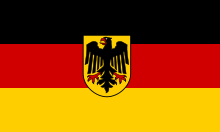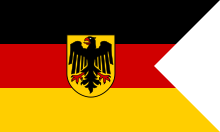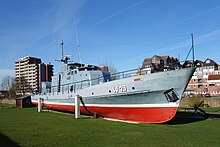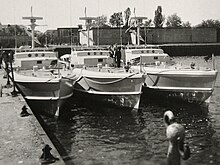Sea border protection
The Maritime Border Guard was part of the Federal Border Guard , which existed from 1951 to 1956. It is to be distinguished from the Federal Border Police (See) , which was set up in 1964 and has been called the Federal Police (See) since 2005 .
history
Development of the maritime border protection
The Federal Border Guard (BGS) was planned after the establishment of the Federal Republic of Germany . The Constitution Act was passed in the Federal Cabinet on November 14, 1950 and passed by the Bundestag on February 15, 1951 . The construction of the BGS began in March 1951. The scope was initially to be 10,000 men, 500 of them in the Maritime Border Guard, known as the coastal protection department .
On July 1, 1951, the first 96 men came from the disbanded mine clearing association Cuxhaven . The target strength was achieved by the end of 1951. While the officers and non-commissioned officers had all served in the Navy , 230 unserved sailors were hired. As a flag, the boats carried the federal service flag . In addition, as in military associations, command signals were used for the commanders, the flotilla chiefs and the association chief. Later the maritime border protection increased to 1200 men.
In 1952 the regular training operation began, in which first the individual boats and then the flotillas were prepared for their tasks. The training of the flotillas ended with an inspection by the head of the Maritime Protection Association. In the winter of 1952/53, the first mission trips in the Baltic Sea could be undertaken.
Further planning
In 1952 the Treaty on the European Defense Community was concluded. It envisaged the establishment of West German armed forces as part of a European armed force. The power of disposal over the German forces would have rested solely with a European commander. In the course of the accompanying German deliberations, the former Vice Admiral Hellmuth Heye suggested that, in parallel with the establishment of German armed forces, the maritime border protection should be strengthened so that in the event of a war there would be one's own means to carry out security tasks including mine defense on the German coasts. Furthermore, in 1953, after he had been elected to the Bundestag for the CDU , Heye proposed that all federal seagoing vessels of the time be merged into a coast guard. This failed, among other things, because of the resistance of the Ministry of Agriculture responsible for fisheries protection and the Ministry of Finance responsible for maritime customs .
Independent of these developments, plans for the expansion of the maritime border protection had been in place in the Federal Ministry of the Interior since autumn 1951 . On June 19, 1953, the Bundestag decided to increase the number of employees from 500 to 1,550 civil servants. The sea border protection , which was previously carried out directly from the ministry, was to be subordinated to a fourth coastal border protection command to be set up , to which, in addition to sea and land units, should be assigned. The vehicles provided were 6 large and 18 small watch boats, 12 large and 4 small patrol boats, 6 safety boats, 3 school boats and 3 other vehicles.
The new border protection command, consisting predominantly of sea border protection units, should have been under the leadership of a sea border protection officer who, analogous to the ranks of the land border protection, would have been designated as an admiral in the BGS . This position should Rear Admiral a. D. Ernst Lucht , who had agreed to do so on request.
After the federal election in 1953 , the leadership of the Federal Ministry of the Interior changed, and the new Interior Minister Gerhard Schröder did not support the extensive plans for the expansion of the sea border protection. Instead, there should be only a minor increase to around 700 men to remedy the understaffing of the ships. As a compromise, a number of around 1000 was provisionally set on the assumption that the number of ships would continue to grow.
In order to limit the independence of the Maritime Border Guard in the form of direct assignment under the Ministry, it was subordinated to the Coastal Border Guard Command and should be renamed the Federal Border Guard Sea . This renaming was no longer in effect until the sea border protection was dissolved, but it applied to the sea border protection association that was newly established in 1964. Since the land units in the coastal border protection command were predominant compared to the smaller sea border protection, the leadership by an admiral was also omitted.
Transfer to the German Navy
When the Bundeswehr was set up in 1955 , many members of the Federal Border Police were taken over. While the land border protection was subsequently reorganized, the sea border protection was dissolved and only reorganized in 1964.
On January 2, 1956, the establishment of the German Navy began , the handover of the personnel and material of the maritime border protection took place on July 1, 1956, exactly five years after its establishment, with a ceremonial change of flag. The transfer took place in close coordination with Department VII (Navy) in the Federal Ministry of Defense . Ongoing tasks were continued as far as they were taken over by the Navy. Several boats led u. a. P 2 and W 13 change flags at sea so as not to interrupt their orders. In addition, the Maritime Border Guard supported the Navy during the transition period, among other things, by providing the escort ships Eider and Trave as training ships for the first crew of officer candidates for the Navy, who thus received their first on-board training on ships of the Maritime Border Guard. Together with the six large watch boats of the 3rd watch boat flotilla, both ships formed the Baltic Sea School Squadron of the German Navy, where they continued their training immediately.
On July 1, 1956, about 700 members moved to the German Navy. In addition, there were officers from the land border guard who wanted to switch to the navy, so that they could take over a total of 872 BGS members, while 142 officers from the sea border guard opted for service in the land border guard. The material was handed over completely. Until it was re-established as the Federal Border Guard See in autumn 1964, sea border protection tasks were taken over by seagoing boats of the customs administration and the Schleswig-Holstein water police . The initiative for re-erection came from both the Federal Ministry of the Interior and the state government of Schleswig-Holstein. (Lappoehn, p. 472)
tasks
The tasks of the Federal Border Guard resulted from the Federal Border Guard Act of 1951. They applied in the same way to the maritime border protection and mainly included border security against illegal crossings and border-endangering disturbances as well as passport inspection. For maritime border protection, this included monitoring the territorial waters with a focus on the Ostholstein Baltic Sea coast.
In the course of time, the maritime border protection was given special tasks that arose in the coastal area. This included the sea-side security in front of the Todendorf and Putlos shooting ranges , which were used by the Allied troops, which was taken over from June 1952. At the request of the state of Schleswig-Holstein and the city of Kiel, the sea border protection supported the implementation of the Kiel Week from 1952 . From 1954 a liaison officer was provided to coordinate the cooperation between the Royal Air Force and German agencies with regard to the use of the Knechtsand bombing site . In addition, the Maritime Border Guard supported the German Hydrographic Institute in systematically collecting radar images of the German Baltic Sea coast in order to create a radar laser.
organization
guide
The maritime border protection was directly subordinate to the Federal Ministry of the Interior. Division VI C 6 was responsible here, the head of which, the former sea captain Fritz Poske, led the maritime border protection with the rank of captain in the BGS . The unit was responsible for all administrative matters including procurement, budget, maritime law, equipment and cooperation with other agencies. In terms of training, it was independent of the training department of the BGS, which was only responsible for training the border guards.
The Maritime Protection Association under Oberstabskapitän i. BGS Knuth, later the two sea border protection associations, and the school and repair group under staff captain i. BGS from Blanc . Both associations were located in Neustadt in Holstein .
structure
The sea border protection association was initially divided into three sea border protection flotillas, each of which was led by a captain lieutenant i. BGS were conducted. The two escort ships Eider and Trave, procured in 1953 and 1954, were directly subordinate to the head of the association. Later, a fourth flotilla, consisting of small watch boats, with its home port in Kiel, was added, and the association was divided into the I. and II. Maritime Border Protection Association, each with two flotillas.
The organizational plan for 1955 provided the following structure for the sea border protection group , which was now subordinate to the coastal border protection command and was led by the sea border protection group in Kiel:
- Maritime Border Protection Association I, Neustadt / Holstein
- 1. Guard boat flotilla, 6 small guard boats
- 2. Guard boat flotilla, 6 small guard boats
- Patrol boat flotilla, 4 patrol boats
- Escort ship Eider
- Maritime Border Protection Association II, Kiel
- 3. Guard boat flotilla, 6 large guard boats
- 4. Guard boat flotilla, 6 small guard boats
- Security boat flotilla, 3 security boats
- Escort ship Trave
- Maritime Border Protection Tribe Department, Cuxhaven
- Tribe hundred
- Teaching hundredth
- School boat group, 3 school boats
- Repair and equipment center, Kiel
- Repair shops and workshops
- Tanker Eutin , tug Plön
In addition to the main Neustadt base, there were smaller bases in Kiel-Wik and Cuxhaven . The base in Cuxhaven consisted of a former naval arsenal and was taken over in October 1951. In December 1951, well-equipped base and workshop facilities of the Kriegsmarine were taken over in Kiel, which were expanded into a repair shop.
From 1953, the British occupying forces in Cuxhaven also made pier facilities of the former German mine-sweeping port available, which were used by the school and repair group.
Ships and boats

In 1955, the Maritime Border Guard had a total of 38 vessels. Their equipment was subject to considerable restrictions by the occupying powers . Arming with 20 mm guns was refused, as was the procurement of powerful, fast guard boats. Although Chancellor Adenauer personally wrote a letter to the Allied High Commission at the beginning of 1953 and, because of the tense security situation, applied for approval to improve the equipment of the Federal Border Guard, many of these demands remained unfulfilled. Therefore, the ships and boats were essentially left unarmed. The already initiated procurement of 20 mm guns from Switzerland with the participation of the arms dealer Rudolf Ruscheweyh became part of the first arms scandal in the Federal Republic of Germany.
Guard boats
The Maritime Border Guard had three types of watch boats, which were initially referred to as small, large and fast watch boats.
The small guard boats were former war fishing cutters (KFK) that the Navy had built. They were uniformly rebuilt for sea border protection. They received a round structure on the forecastle, in which there were sanitary facilities. Armament with a 20-mm gun was intended on this structure, but this was not approved by the Allies. The boats received a radar device and radio and signal equipment. These small vessels of 24 m in length and 110 tonnes (t) displacement were indeed seaworthy but very slow at 9 knots (kn).
The large guard boats , six of which were purchased, were former MMS (Motor Minesweeper) mine sweepers made in Canada. At 36.8 m and 190 t, these boats were significantly larger than the KFK, but with a top speed of 11 kn they were only marginally faster. Their equipment and armament corresponded to those of the small guard boats.
In addition to these slow types, fast guard boats were needed to keep up with faster ships at sea. The choice fell on a type that the US Navy had commissioned several boats from the Lürssen shipyard for their Weser River Patrol . With a displacement of around 70 t and a length of 28.8 m, the boats should be 26 to 29 knots. As armament, three 20 mm guns, two of them in twin arrangement, were provided. Four boats with slightly different propulsion systems were ordered and delivered as newbuildings in the second half of 1952. The vehicles were later referred to as patrol boats .
Belay boats
In view of the threat to the establishment of the barracked people's police , the German interior ministry decided to procure suitable fast watch boats for maritime border protection and commissioned them on February 8, 1952 from the Lürssen shipyard in Bremen - Vegesack . An application for approval from the Allied Military Security Office (MSA) was waived because the new buildings were not considered to require approval. After a lengthy discussion, the Allies banned procurement by German authorities.
In the fall of 1954 it was agreed to hand over the existing hulls to the British Baltic Fishery Protection Service for a fee, which had the boats completed and put into service. At the same time a formal application was made to build three more boats. This application was approved on May 3, 1955 two days before the entry into force of the Treaty of Paris , the occupation statute in the Federal Republic of Germany has been completed and the NATO joining.
Two of the three boats of the second series were completed in autumn 1955 and handed over to the maritime border protection. The third boat was only delivered in September 1956 and taken over directly by the German Navy. Together with the returned British boats, they formed the herring gull class consisting of six boats , which were combined in the 1st Schnellbootgeschwader .
other vehicles
The two escort ships Eider and Trave and the school boats Nordwind and Falke were also available on other vehicles .
The Eider and the Trave were former British Isles class outpost boats built in 1942 . Little is known about their fate from 1947 to 1951. The Maritime Border Guard acquired the two ships in Belgium , where they were being converted into fishing vessels and had been lengthened by four meters for this purpose. The Eider kept the original steam propulsion system. This had already been expanded on the Trave and was replaced by a diesel-electric drive . The two ships were 53.9 m long and displaced about 750 t when fully equipped. They reached a top speed of 13 knots.
The falcon , a former air traffic control boat of the Air Force, served as a school boat . With a length of 18.1 m it displaced 30 t and could run about 12 kn. The sailing school boat Nordwind was a converted war fishing cutter that had been rigged as a ketch .
References
Web links
literature
- Hartmut Klüver (ed.): Stations of German naval history (II): German sea associations 1945–1956 , Düsseldorf 2001, ISBN 3-935091-08-7
- Fritz Poske: The sea border protection 1951-1956. Reminder - report - documentation . Koblenz / Bonn 1982, ISBN 3-7637-5410-5
- Captainleutnant i. BGS Siegfried Lappoehn: Federal Border Police See , in: Troop practice. Journal for tactics, technology and training , year 1971, issue 6, pp. 472–474.
Individual evidence
- ↑ a b c Hanns Postel: The sea border protection . In: Hartmut Klüver (Ed.): Stations of German naval history (II): German sea associations 1945–1956 , Düsseldorf 2001, ISBN 3-935091-08-7
- ↑ a b c d e f g h Fritz Poske : The sea border protection 1951–1956. Reminder - report - documentation . Koblenz / Bonn 1982. ISBN 3-7637-5410-5
- ^ Siegfried Breyer, Gerhard Koop (1996): The ships, vehicles and aircraft of the German Navy from 1956–1976 , Bonn 1978, ISBN 3-7637-5155-6
- ↑ a b History of sea border protection at bundespolizei.de ( Memento from July 18, 2011 in the Internet Archive )
- ↑ a b Letter from Adenauer to the Executive Chairman of the Allied High Commission, Conant dated February 21, 1953 (PDF; 21 kB)
- ↑ Report in DER SPIEGEL
- ^ Cabinet minutes






